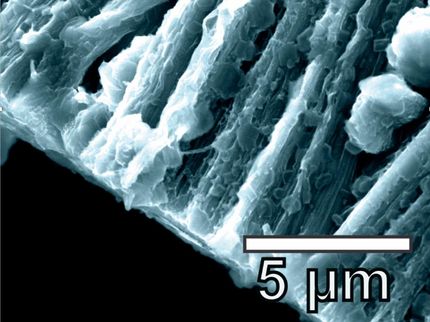New design points a path to the 'ultimate' battery
Scientists have developed a working laboratory demonstrator of a lithium-oxygen battery which has very high energy density, is more than 90% efficient, and, to date, can be recharged more than 2000 times, showing how several of the problems holding back the development of these devices could be solved.
However, as is the case with other next-generation batteries, there are several practical challenges that need to be addressed before lithium-air batteries become a viable alternative to gasoline.
Now, researchers from the University of Cambridge have demonstrated how some of these obstacles may be overcome, and developed a lab-based demonstrator of a lithium-oxygen battery which has higher capacity, increased energy efficiency and improved stability over previous attempts.
Their demonstrator relies on a highly porous, 'fluffy' carbon electrode made from graphene (comprising one-atom-thick sheets of carbon atoms), and additives that alter the chemical reactions at work in the battery, making it more stable and more efficient. While the results are promising, the researchers caution that a practical lithium-air battery still remains at least a decade away.
"What we've achieved is a significant advance for this technology and suggests whole new areas for research - we haven't solved all the problems inherent to this chemistry, but our results do show routes forward towards a practical device," said Professor Clare Grey of Cambridge's Department of Chemistry.
Many of the technologies we use every day have been getting smaller, faster and cheaper each year - with the notable exception of batteries. Apart from the possibility of a smartphone which lasts for days without needing to be charged, the challenges associated with making a better battery are holding back the widespread adoption of two major clean technologies: electric cars and grid-scale storage for solar power.
"In their simplest form, batteries are made of three components: a positive electrode, a negative electrode and an electrolyte,'' said Dr Tao Liu, also from the Department of Chemistry.
In the lithium-ion (Li-ion) batteries we use in our laptops and smartphones, the negative electrode is made of graphite (a form of carbon), the positive electrode is made of a metal oxide, such as lithium cobalt oxide, and the electrolyte is a lithium salt dissolved in an organic solvent. The action of the battery depends on the movement of lithium ions between the electrodes. Li-ion batteries are light, but their capacity deteriorates with age, and their relatively low energy densities mean that they need to be recharged frequently.
What Liu, Grey and their colleagues have developed uses a very different chemistry than earlier attempts at a non-aqueous lithium-air battery, relying on lithium hydroxide (LiOH) instead of lithium peroxide (Li2O2). With the addition of water and the use of lithium iodide as a 'mediator', their battery showed far less of the chemical reactions which can cause cells to die, making it far more stable after multiple charge and discharge cycles.
By precisely engineering the structure of the electrode, changing it to a highly porous form of graphene, adding lithium iodide, and changing the chemical makeup of the electrolyte, the researchers were able to reduce the 'voltage gap' between charge and discharge to 0.2 volts. A small voltage gap equals a more efficient battery - previous versions of a lithium-air battery have only managed to get the gap down to 0.5 - 1.0 volts, whereas 0.2 volts is closer to that of a Li-ion battery, and equates to an energy efficiency of 93%.
The highly porous graphene electrode also greatly increases the capacity of the demonstrator, although only at certain rates of charge and discharge. Other issues that still have to be addressed include finding a way to protect the metal electrode so that it doesn't form spindly lithium metal fibres known as dendrites, which can cause batteries to explode if they grow too much and short-circuit the battery.
Additionally, the demonstrator can only be cycled in pure oxygen, while the air around us also contains carbon dioxide, nitrogen and moisture, all of which are generally harmful to the metal electrode.
Original publication
Other news from the department science

Get the chemical industry in your inbox
From now on, don't miss a thing: Our newsletter for the chemical industry, analytics, lab technology and process engineering brings you up to date every Tuesday and Thursday. The latest industry news, product highlights and innovations - compact and easy to understand in your inbox. Researched by us so you don't have to.



























































